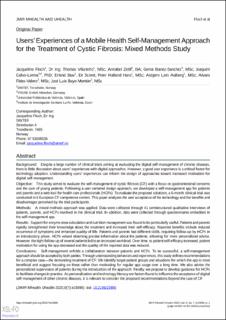| dc.contributor.author | Floch, Jacqueline | |
| dc.contributor.author | Vilarinho, Thomas | |
| dc.contributor.author | Zettl, Annabel | |
| dc.contributor.author | Ibanez-Sánchez, Gema | |
| dc.contributor.author | Calvo-Lerma, Joaquim | |
| dc.contributor.author | Stav, Erlend | |
| dc.contributor.author | Haro, Peter | |
| dc.contributor.author | Aalberg, Asbjørn Lein | |
| dc.contributor.author | Fides-Valero, Alvaro | |
| dc.contributor.author | Montón, José Luis Bayo | |
| dc.date.accessioned | 2023-03-28T13:13:45Z | |
| dc.date.available | 2023-03-28T13:13:45Z | |
| dc.date.created | 2020-08-14T15:36:24Z | |
| dc.date.issued | 2020 | |
| dc.identifier.citation | JMIR mhealth and uhealth. 2020, 8 (7), e15896. | en_US |
| dc.identifier.issn | 2291-5222 | |
| dc.identifier.uri | https://hdl.handle.net/11250/3060763 | |
| dc.description.abstract | Background: Despite a large number of clinical trials aiming at evaluating the digital self-management of chronic diseases, there is little discussion about users’ experiences with digital approaches. However, a good user experience is a critical factor for technology adoption. Understanding users’ experiences can inform the design of approaches toward increased motivation for digital self-management.
Objective: This study aimed to evaluate the self-management of cystic fibrosis (CF) with a focus on gastrointestinal concerns and the care of young patients. Following a user-centered design approach, we developed a self-management app for patients and parents and a web tool for health care professionals (HCPs). To evaluate the proposed solutions, a 6-month clinical trial was conducted in 6 European CF competence centers. This paper analyzes the user acceptance of the technology and the benefits and disadvantages perceived by the trial participants.
Methods: A mixed methods approach was applied. Data were collected through 41 semistructured qualitative interviews of patients, parents, and HCPs involved in the clinical trial. In addition, data were collected through questionnaires embedded in the self-management app.
Results: Support for enzyme dose calculation and nutrition management was found to be particularly useful. Patients and parents rapidly strengthened their knowledge about the treatment and increased their self-efficacy. Reported benefits include reduced occurrence of symptoms and enhanced quality of life. Patients and parents had different skills, requiring follow-up by HCPs in an introductory phase. HCPs valued obtaining precise information about the patients, allowing for more personalized advice. However, the tight follow-up of several patients led to an increased workload. Over time, as patient self-efficacy increased, patient motivation for using the app decreased and the quality of the reported data was reduced.
Conclusions: Self-management enfolds a collaboration between patients and HCPs. To be successful, a self-management approach should be accepted by both parties. Through understanding behaviors and experiences, this study defines recommendations for a complex case—the demanding treatment of CF. We identify target patient groups and situations for which the app is most beneficial and suggest focusing on these rather than motivating for regular app usage over a long time. We also advise the personalized supervision of patients during the introduction of the approach. Finally, we propose to develop guidance for HCPs to facilitate changes in practice. As personalization and technology literacy are factors found to influence the acceptance of digital self-management of other chronic diseases, it is relevant to consider the proposed recommendations beyond the case of CF. | en_US |
| dc.language.iso | eng | en_US |
| dc.publisher | JMIR Publications | en_US |
| dc.relation.uri | https://mhealth.jmir.org/2020/7/e15896/ | |
| dc.rights | Navngivelse 4.0 Internasjonal | * |
| dc.rights.uri | http://creativecommons.org/licenses/by/4.0/deed.no | * |
| dc.title | Users’ Experiences of a Mobile Health Self-Management Approach for the Treatment of Cystic Fibrosis: Mixed Methods Study | en_US |
| dc.type | Peer reviewed | en_US |
| dc.type | Journal article | en_US |
| dc.description.version | publishedVersion | en_US |
| dc.rights.holder | © 2020 Jacqueline Floch, Thomas Vilarinho, Annabel Zettl, Gema Ibanez-Sanchez, Joaquim Calvo-Lerma, Erlend Stav, Peter Halland Haro, Asbjørn Lein Aalberg, Alvaro Fides-Valero, José Luis Bayo Montón. | en_US |
| dc.source.volume | 8 | en_US |
| dc.source.journal | JMIR mhealth and uhealth | en_US |
| dc.source.issue | 7 | en_US |
| dc.identifier.doi | 10.2196/15896 | |
| dc.identifier.cristin | 1823411 | |
| dc.relation.project | EC/H2020/643806 | en_US |
| dc.source.articlenumber | e15896 | en_US |
| cristin.ispublished | true | |
| cristin.fulltext | original | |
| cristin.qualitycode | 1 | |

